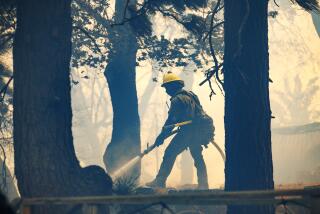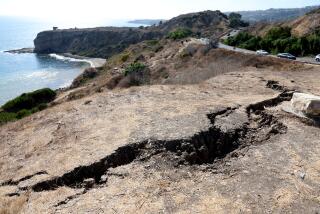In canyon disaster plan, neighbors help evacuees
A particularly hot and early fire season has arrived this year. Time to clear brush, make a family plan and, if you’re a Topanga Canyon resident, perhaps prepare for company.
Under a plan implemented last year, 38 privately owned properties in the unincorporated community have been designated “neighborhood survival areas” -- last-resort refuges for residents unable to evacuate or get to predetermined public safety zones within the canyon.
Topanga Canyon, a beautiful but catastrophe-prone area, is the site of a Los Angeles County-sponsored pilot program to create disaster evacuation and safety plans.
Although cities have their own survival plans, unincorporated areas of Los Angeles County, often more vulnerable to the elements because they’re near open land and brush, frequently do not. So, the county assessed its unincorporated areas to decide which one was most in need of help.
Topanga Canyon fit the bill.
“Almost every kind of disaster that has hit L.A. County over the last decade” -- floods, landslides, earthquakes and fires -- has been experienced there, said Susan Nissman, senior field deputy to County Supervisor Zev Yaroslavsky and lead coordinator of the Topanga Emergency Management Plan.
Because most residents rely on a single road -- Topanga Canyon Boulevard -- to get into and out of their neighborhood, a Santa Ana wind-driven fire could cross the canyon and reach the Pacific before people are able to evacuate. So, residents need a nearby place where they can seek shelter.
To provide refuge to as many of Topanga Canyon’s 5,500 residents as possible, planners divided the canyon into nine tactical zones, each containing a safety area on public land that firefighters can more easily defend. Eight of the nine zones also include areas on private property -- both homeowners’ yards and vacant lots -- where fire personnel will protect residents waiting to be evacuated.
These refuges, chosen because of their topography, lack of brush or proximity to fire trails, are identified on maps in the “Topanga Disaster Survival Guide.” Copies of the guide have been mailed to each canyon residence, said Maria Grycan, the county fire department’s community service representative.
Of course, public officials are legally permitted to commandeer private property in an emergency. But this is the first time that use has been included before such an emergency occurs.
What does this mean for the homeowners who were selected?
Potentially, hundreds of neighbors could show up suddenly in a homeowner’s yard. Property owners don’t have to let people into their homes, but the emergency hosts contacted for this story appeared inclined to be gracious. No one has yet complained to the county about being chosen.
Fire awareness is a major part of Topanga’s gestalt -- the survival guide refers to the canyon as a “perilous paradise.”
“It’s very much in our sinew,” said Jens Koepke, a Topanga homeowner and attorney. “Every year, we cut our brush, and we get inspected for brush clearance. If people park in a way that would block access to fire trucks, we’ll call them on it.”
So far, the program appears to be well received by residents.
“If our family could help another family,” Koepke said, “we’d be happy and willing to do so.”
One concern -- the potential for property damage and who would be liable -- isn’t addressed in the materials mailed by the county. But county counsel Eric Young said local government generally is not liable for damage caused during an emergency.
Residents seem inured to such concerns, and some are adamant about the necessity of neighborhood cooperation.
Gregory Smith said he would be upset if a fellow Topanga resident caused damage to his property, but that wouldn’t prevent him from wanting to do his part in the event of a disaster. “We’d be a little more high-minded than that,” he said.
Yaroslavsky aide Nissman said the county would probably set up similar programs in other unincorporated areas. Under consideration are areas near Santa Clarita and Lancaster.
More to Read
Sign up for Essential California
The most important California stories and recommendations in your inbox every morning.
You may occasionally receive promotional content from the Los Angeles Times.










